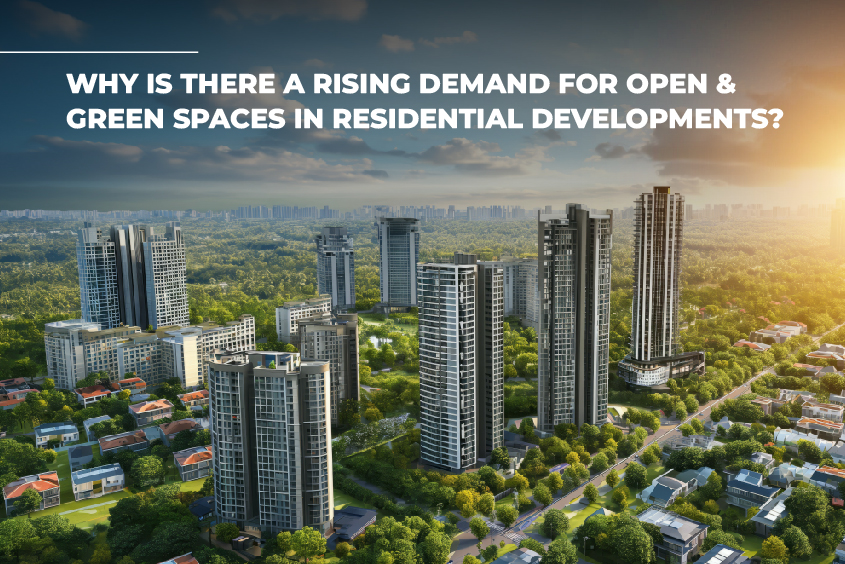In the heart of every urban dweller lies an innate longing for connection with nature, a yearning for the tranquillity and serenity that greenery and open spaces provide. Yet, the reality of modern urban living often presents a stark contrast, where concrete jungles overshadow the presence of lush landscapes.
As cities expand and populations surge, the scarcity of greenery and open spaces becomes increasingly apparent, posing significant challenges to the well-being and sustainability of urban environments. However, amidst this concrete sprawl, the integration of nature into urban landscapes emerges as a crucial solution, offering respite from pollution, fostering mental and physical health, and nurturing vibrant communities. This prompts us to delve into the importance of open spaces and greenery in residential development, unraveling their multifaceted benefits and exploring strategies for their effective implementation.
The Necessity of Green Spaces
Green spaces serve as sanctuaries amidst the urban chaos, offering individuals vital opportunities to rejuvenate and reconnect with nature. Research consistently highlights their profound impact on mental health and well-being, with studies showing that exposure to greenery reduces stress, anxiety, and depression. Imagine living amidst scenic and green views of nature, less pollution, and a fresh environment. Just the thought of it invigorates the mind!
Green spaces are known to play a pivotal role in purifying the air and enhancing ventilation, countering the detrimental effects of pollution prevalent in densely populated urban areas. Hence, urban homebuyers are keen on choosing residential projects with more open spaces and green pockets.
Benefits of Living in a Green Environment
In residential settings, the presence of green spaces becomes even more significant, influencing various aspects of residents’ lives. Green spaces encourage physical activity, serving as venues for recreational pursuits and exercise.
Many new-age real estate developers in Mumbai and other metro cities are into curating nature-infused amenities for the residents. Rooftop garden spaces with jogging tracks, open gyms, and yoga decks are gaining popularity amongst urban homebuyers.
Apart from the health benefits and recreation offered by these green spaces, they also foster social cohesion and community spirit for the kids, senior citizens, and couples alike. These gathering spots encourage interaction and bonding while cultivating a sense of belonging.
The Environmental Impact
Beyond their human-centric benefits, green spaces play a pivotal role in preserving ecological equilibrium. They support biodiversity by providing habitats for diverse flora and fauna, contributing to the conservation of species. Furthermore, green spaces serve as natural stormwater management systems, mitigating the risk of flooding by absorbing and infiltrating rainwater. Transplanting exotic and fruit-bearing trees is a new way of infusing greenery into the environment. They exude more oxygen in the air, help combat the urban heat island effect, and reduce temperatures in built-up areas. They promote overall climate resilience, too.
Implementing Green Spaces in Urban Development
Integrating green spaces into residential projects requires thoughtful planning and strategic implementation. Factors such as location, design, and community needs must be carefully considered to ensure the efficacy and sustainability of these spaces. Drawing inspiration from successful examples worldwide, developers and city planners have started to adopt innovative approaches to incorporate greenery into urban landscapes, fostering vibrant and liveable communities.
These spaces look aesthetically pleasing and add value to your otherwise typical community living. The residents feel urge to step out of their homes due to the pleasant environment these spaces create.
The concept of vertical gardens is gaining much popularity among the new-age developers as they are easy to maintain and save space while adding a nature element to the projects.
Conclusion:
In conclusion, the significance of open spaces and greenery in residential development cannot be overstated. They serve as essential components of healthy, sustainable, and community-oriented urban environments, enriching the lives of residents and enhancing the fabric of society. Green spaces are also great for mental and physical well-being. They reduce overall temperatures and improve the Air Quality Index (AQI), which happens to be an essential factor in metro cities covered in concrete jungles.
As we navigate the challenges of urbanization, it is imperative to prioritize the creation and preservation of green spaces, advocating for their integration into current and future residential developments. By doing so, developers are trying to cultivate cities that thrive in harmony with nature, nurturing the well-being of both present and future generations.
If you are looking for residential projects in Mumbai that offer green spaces with nature-infused amenities, check out the luxurious properties by Runwal Group. The 36-acre premier township at Runwal City Centre in Kanjurmarg is crafted with open and green spaces to encourage residents to live an active lifestyle. With 8-acre Central Park, spacious cricket ground and other amenities like terrace gardens and yoga decks, Runwal City Centre is crafted with the concept of green living. Similarly, Runwal Garden City in Dombivli is a thoughtfully curated 250+ acres of township with 70% open spaces and 34+ gardens, multiple cricket grounds and nature-infused amenities. Explore these projects by Runwal Group and bring more nature into your routine.


 SHARE
SHARE
